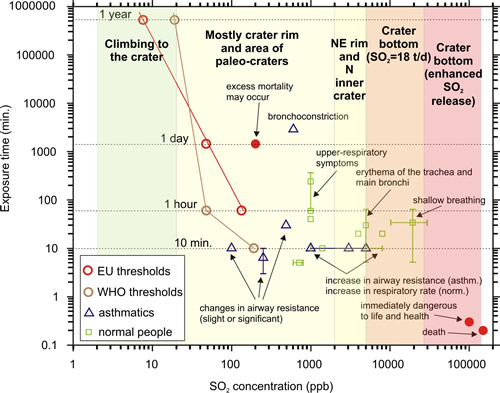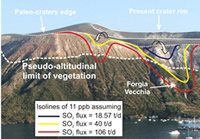Volcanogenic SO2, a natural pollutant: Measurements, modeling and hazard assessment at Vulcano Island (Aeolian Archipelago, Italy)
Granieri D., F. Vita, S. Inguaggiato (2017).
Environmental Pollution, 231/1, 219-228, https://doi.org/10.1016/j.envpol.2017.07.101.
![]()
Abstract
 Sulfur dioxide (SO2) is a major component of magmatic gas discharges. Once emitted in the atmosphere it can affect the air and land environment at different spatial and temporal scales, with harmful effects on human health and plant communities.
Sulfur dioxide (SO2) is a major component of magmatic gas discharges. Once emitted in the atmosphere it can affect the air and land environment at different spatial and temporal scales, with harmful effects on human health and plant communities.
We used a dense dataset of continuous SO2 flux and meteorological measurements collected at Vulcano over an 8-year period spanning from May 2008 to February 2016 to model air SO2 concentrations over the island. To this end, we adopted the DISGAS (DISpersion of GAS) numerical code coupled with the Diagnostic Wind Model (DWM). SO2 concentrations in air were determined for three different SO2 emission rates: a reference SO2 flux of ∼18 t/d (the median of more than 800 measurements), an enhanced SO2 flux of 40 t/d (average of all measurements plus 1 σ), and a maximum SO2 flux of 106 t/d (maximum value measured in the investigated period). Maximum SO2 concentrations in air were estimated at the crater, near the high-T fumarole field that is the source of the gas, and ranged from 2000 ppb to ∼24,000 ppb for the reference flux, from 2000 ppb to 51,000 ppb for the enhanced flux and from 5000 ppb to 136,000 ppb for the maximum flux, with peak values in limited areas at the bottom of the crater. These concentrations pose a hazard for people visiting the crater, for sensitive individuals in particular. Based on estimated SO2 concentrations in air, we also consider the phytotoxic effects of SO2 on local vegetation.
http://www.sciencedirect.com/science/article/pii/S0269749117316147



Devi effettuare l'accesso per postare un commento.